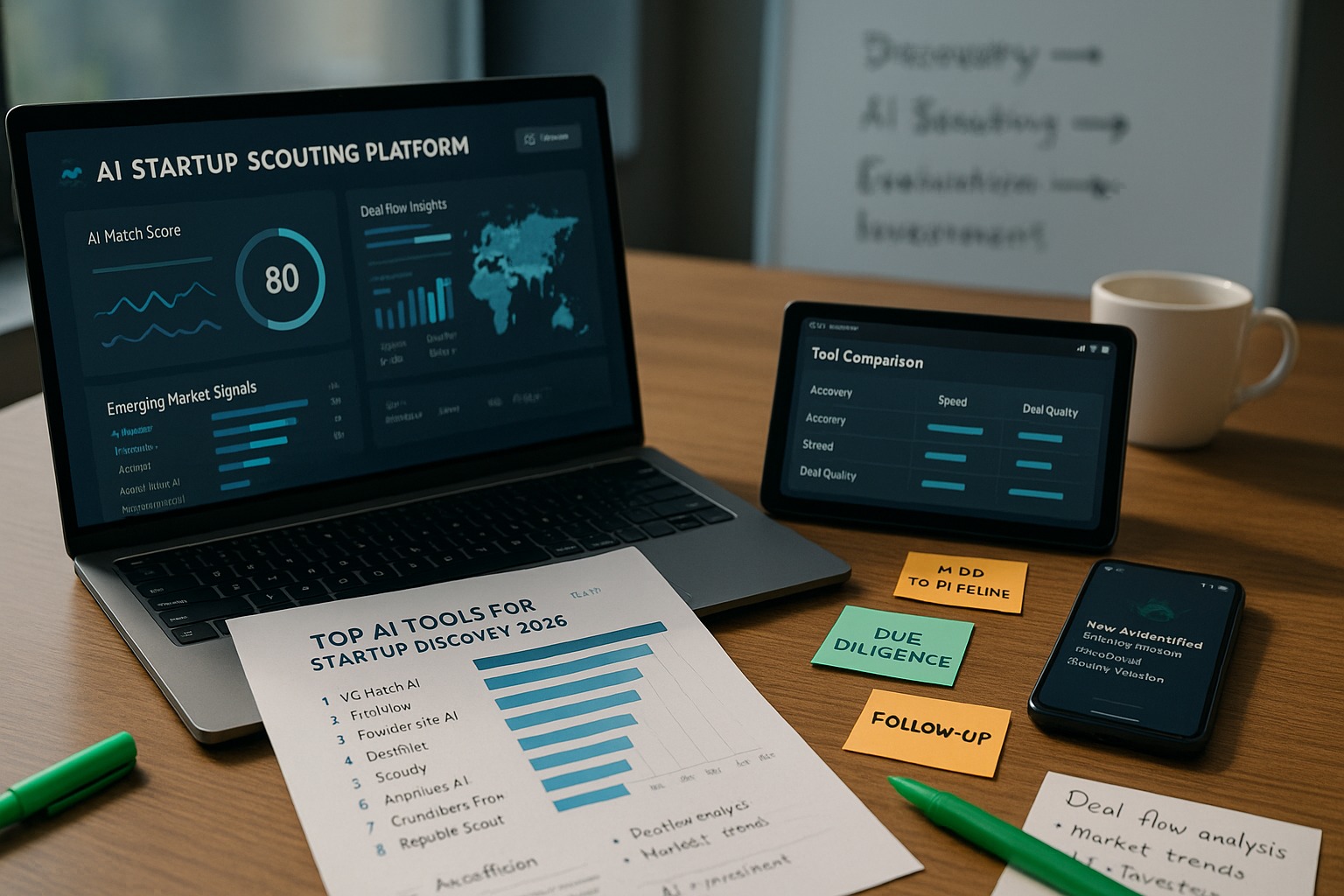Top AI-Powered Tools for Startup Discovery and Scouting in 2026
The venture capital landscape has undergone a dramatic transformation as AI-powered tools reshape how investors discover and evaluate promising startups. Traditional manual scouting methods that once required weeks of research can now be completed in minutes through sophisticated automation and predictive analytics.
Modern investors face an unprecedented challenge: sifting through millions of emerging companies across global markets to identify the next breakthrough opportunity. AI-driven scouting platforms have emerged as the solution, offering speed, scale, and precision that manual processes simply cannot match.
This comprehensive guide examines the top AI-powered tools revolutionizing startup discovery in 2026, providing practical frameworks for selection and integration into your investment workflow.
Rise Of AI In Startup Scouting
Traditional startup scouting relied heavily on personal networks, industry events, and manual database searches. This approach limited investors to a narrow pool of opportunities and introduced significant time delays in deal discovery. The process was often reactive rather than proactive, missing emerging trends and early-stage companies operating outside established circles.
Startup scouting refers to the systematic process of identifying and evaluating early-stage companies that align with specific investment criteria. For investors and corporations, effective scouting forms the foundation of successful portfolio construction and strategic partnerships. The quality of deal flow directly correlates with long-term investment performance.
AI automation has revolutionized this landscape by delivering three critical advantages. Speed allows investors to process thousands of companies simultaneously rather than evaluating them one by one. Scale enables comprehensive coverage of global markets and emerging sectors that would be impossible to monitor manually. Precision helps identify high-potential opportunities through sophisticated pattern recognition and predictive modeling that surpasses human analytical capabilities.
Criteria For Evaluating Scouting Platforms
Selecting the right AI-powered scouting tool requires a systematic evaluation framework that considers both technical capabilities and practical implementation needs. First-time users often focus exclusively on features while overlooking critical factors like data quality, integration complexity, and long-term scalability.
The evaluation process should prioritize four key dimensions that directly impact platform effectiveness and user adoption. These criteria provide a structured approach for comparing tools and making informed selection decisions.
Data Coverage And Freshness
Comprehensive startup databases form the foundation of effective scouting platforms. The breadth of coverage determines whether you can identify opportunities across different sectors, stages, and geographic regions. Leading platforms typically track millions of companies worldwide, but coverage quality varies significantly between regions and industries.
Real-time updates ensure that investment opportunities are identified when they are most actionable. Stale data leads to missed opportunities and inefficient outreach efforts. The best platforms refresh their databases daily and integrate with multiple data sources to capture funding events, team changes, and milestone achievements as they occur.
Global versus regional coverage considerations depend on your investment focus and expansion plans. While comprehensive global platforms offer broader opportunity identification, specialized regional tools often provide deeper local market insights and relationship networks that can be crucial for emerging market investments.
Predictive Analytics And Scoring
Predictive analytics in the startup context refers to AI algorithms that analyze historical patterns and current signals to forecast company success probability. These models consider factors like team composition, market dynamics, funding trajectory, and competitive positioning to generate quantitative scores for prioritization.
AI scoring algorithms help investors focus their limited time on the most promising opportunities. Rather than manually evaluating hundreds of companies, predictive models can rank prospects based on likelihood of success, funding readiness, or strategic fit with your investment thesis. The most sophisticated platforms allow customization of scoring criteria based on your specific preferences and historical performance data.
Integration And Workflow Fit
Compatibility with existing CRM systems and investment workflows determines how seamlessly new tools can be adopted without disrupting established processes. Native integrations with platforms like HubSpot, Salesforce, and specialized investment management systems eliminate manual data entry and ensure consistent information flow across your organization.
API availability and data export capabilities provide flexibility for custom integrations and analytics workflows. Robust APIs allow technical teams to build specialized dashboards, automate reporting, and integrate scouting data with proprietary analytical models. Data export functionality ensures you retain access to valuable information regardless of platform changes.
Pricing Transparency And ROI
Cost considerations extend beyond simple subscription fees to include implementation time, training requirements, and ongoing maintenance needs. Hidden costs often emerge during the integration phase when platforms require extensive customization or additional data sources to deliver promised functionality.
Subscription models versus pay-per-use options cater to different usage patterns and budget structures. High-volume users typically benefit from flat subscription pricing, while occasional users may prefer usage-based models. The key is understanding your expected query volume and user count to select the most cost-effective pricing structure. ROI measurement should focus on time savings, deal quality improvements, and successful investment outcomes rather than simple cost-per-lead metrics.
Top AI-Powered Tools For Startup Discovery
The startup scouting landscape features diverse platforms with distinct capabilities and target audiences. Understanding each tool’s unique value proposition helps investors select platforms that align with their specific needs and investment focus. The following comprehensive analysis examines leading solutions across different categories and use cases.
1. Qubit Capital
Qubit Capital stands out through its AI-powered matchmaking approach that connects startups and investors based on sophisticated compatibility algorithms. The platform analyzes investment preferences, sector focus, stage requirements, and geographic considerations to generate highly targeted recommendations for both sides of the equation.
Global network coverage spans emerging markets often overlooked by traditional Western-focused platforms. The system continuously updates its database through direct startup submissions, partner integrations, and automated web crawling to maintain comprehensive coverage of international opportunities.
End-to-end fundraising support differentiates Qubit Capital from pure discovery platforms by providing active facilitation of connections and deal progression. This comprehensive solution serves both startups seeking funding and investors looking for quality deal flow, creating a robust ecosystem that benefits all participants.
2. Crunchbase
Crunchbase serves as the foundational startup database for most investors, offering comprehensive company profiles and funding history tracking. The platform’s strength lies in its extensive historical data collection and user-contributed content that provides detailed insights into company evolution over time.
Advanced filtering capabilities enable searches by sector, funding stage, geographic location, and dozens of other parameters. Users can create custom searches that automatically update as new companies match their criteria, providing ongoing deal flow without manual effort.
The platform’s API and data export features make it a popular choice for building custom analytical workflows and integrating with proprietary investment management systems.
3. PitchBook
PitchBook emphasizes detailed financial metrics and institutional-grade data quality that meets the standards of professional investment firms. The platform provides comprehensive valuation analysis, funding round details, and investor relationship mapping that supports sophisticated deal evaluation processes.
Private market intelligence capabilities include detailed competitive analysis, market sizing data, and exit outcome tracking. These features help investors understand broader market dynamics and benchmark potential investments against comparable companies.
Integration with major financial data providers and CRM systems makes PitchBook particularly attractive to established investment firms with complex workflow requirements.
4. CB Insights
CB Insights focuses on market intelligence and trend analysis rather than individual company discovery. The platform excels at identifying emerging sectors, technology trends, and competitive dynamics that inform strategic investment decisions.
Industry reports and competitive intelligence features provide context for individual investment opportunities. Users can understand how specific startups fit into broader market trends and technological shifts that may impact long-term success probability.
The platform’s strength in pattern recognition across large datasets helps investors identify emerging opportunities before they become widely recognized by the broader investment community.
5. Traction Technology
Traction Technology offers an end-to-end innovation management platform that extends beyond startup scouting to include partnership development and technology transfer workflows. The system is particularly popular among corporations seeking external innovation opportunities.
Technology database coverage emphasizes deep technical analysis and intellectual property mapping. This focus helps users evaluate the technological differentiation and competitive moats of potential investments or partners.
Collaborative evaluation tools enable team-based assessment workflows with structured scoring frameworks and decision documentation that supports institutional investment processes.
6. ITONICS
ITONICS provides centralized technology scouting with advanced trend mapping capabilities that visualize relationships between technologies, markets, and companies. The platform’s strength lies in its ability to identify convergence opportunities and emerging technology clusters.
Customizable search and filtering capabilities allow users to define complex criteria combining technical parameters, market dynamics, and company characteristics. The system continuously monitors these criteria and alerts users to new opportunities matching their specifications.
Visual analytics tools help users understand technological landscapes and identify gaps where new innovations may emerge, supporting both investment and strategic planning decisions.
7. Signal AI
Signal AI leverages natural language processing to analyze unstructured data sources including news articles, social media, patent filings, and regulatory documents. This approach captures signals that traditional structured databases often miss.
Real-time sentiment tracking provides insights into market perception and momentum around specific companies or technologies. Users can monitor reputation changes and identify emerging controversies or opportunities based on public discourse analysis.
Market signals detection helps users stay ahead of trends by identifying early indicators of technological shifts, regulatory changes, or competitive dynamics that may impact investment attractiveness.
8. AlphaSense
AlphaSense specializes in financial document analysis and alternative data sources that provide unique insights into company performance and market positioning. The platform processes earnings calls, SEC filings, and industry research to extract actionable intelligence.
Research automation capabilities help users quickly synthesize information from multiple sources and identify key themes or concerns that may not be apparent from standard financial metrics alone.
Alternative data integration includes satellite imagery, social media activity, and patent analysis that provides early indicators of company traction and market opportunity validation.
Emerging Platforms To Watch
The startup scouting landscape continues to evolve as new platforms introduce innovative approaches and expand coverage to previously underserved markets. These emerging solutions often focus on specific niches or technological advances that address limitations of established platforms.
Platform Focusing On Africa And LatAm
Specialized platforms are expanding coverage to emerging innovation hubs across Africa and Latin America where traditional Western databases often provide limited visibility. These tools leverage local partnerships and native language processing to identify opportunities that would be missed by global platforms.
Unique market insights include understanding of local regulatory environments, cultural factors, and economic conditions that significantly impact startup success probability. Local expertise helps investors navigate complex regional dynamics and identify companies with strong domestic positioning.
These platforms often provide direct connections to local investor networks and strategic partners, facilitating not just discovery but also practical investment execution in challenging regulatory environments.
Blockchain-Verified Startup Databases
Blockchain technology addresses persistent data accuracy challenges by creating tamper-proof records of company achievements, funding events, and milestone progression. This approach reduces the risk of fraudulent claims and provides investors with verified information for decision-making.
Tamper-proof achievement records enable more reliable track record verification and reduce due diligence time by providing cryptographically secured evidence of company progress and team credentials.
Smart contract integration can automate certain aspects of the investment process, including milestone-based funding releases and automated compliance monitoring that reduces administrative overhead.
Niche Sector Discovery Engines
Specialized platforms focusing on specific industries like healthtech, fintech, or cleantech offer deep domain expertise that general-purpose tools cannot match. These platforms understand sector-specific metrics, regulatory requirements, and competitive dynamics that significantly impact investment attractiveness.
Deep domain expertise includes relationships with industry experts, regulatory bodies, and specialized data sources that provide unique insights into technology validation and market opportunity assessment.
Sector-specific scoring models incorporate industry-relevant factors that may not be captured by general-purpose algorithms, leading to more accurate investment opportunity prioritization within specialized domains.
Integrating Scouting Tools Into Your Deal Flow
Successful adoption of AI-powered scouting tools requires thoughtful integration with existing investment processes rather than wholesale replacement of established workflows. The goal is to enhance human decision-making capabilities while maintaining the relationship-building and expertise application that drive investment success.
For organizations seeking comprehensive startup scouting AI tools that integrate seamlessly with existing processes, the implementation approach determines whether these technologies deliver their promised benefits or become underutilized additions to an already complex toolkit.
Syncing With CRM And Pipeline
Data integration best practices focus on maintaining consistent information flow between scouting platforms and existing customer relationship management systems. This synchronization eliminates manual data entry while ensuring that all team members have access to the same updated information about prospects and ongoing conversations.
Lead scoring automation can be configured to incorporate AI-generated company rankings with internal assessment criteria, creating hybrid scores that combine algorithmic insights with human expertise. This approach helps prioritize outreach efforts while maintaining institutional knowledge about relationship factors and strategic fit.
Pipeline management automation streamlines the progression of opportunities from initial discovery through evaluation stages, ensuring that promising companies receive appropriate attention and follow-up according to established investment processes.
Automating Outreach Workflows
Automated communication sequences can be configured to initiate contact with newly discovered companies while maintaining personalization based on company characteristics and investment thesis alignment. These systems help ensure consistent follow-up without overwhelming internal resources.
Response tracking and follow-up automation capture engagement metrics and schedule appropriate next steps based on prospect responses or lack thereof. This systematic approach prevents opportunities from falling through cracks while maintaining professional communication standards.
Personalization capabilities utilize company-specific information from scouting platforms to craft relevant initial outreach that demonstrates understanding of the business and specific reasons for investor interest.
Collaborative Evaluation Workspaces
Team collaboration features enable multiple team members to contribute insights and assessments while maintaining organized records of evaluation progress. Structured scoring frameworks ensure consistent evaluation criteria across different opportunities and team members.
Shared scoring and note-taking capabilities create institutional memory around investment decisions and rationale, supporting both current decision-making and future portfolio company support activities.
Decision-making workflows can be configured to match internal approval processes while incorporating AI-generated insights as additional data points rather than replacement for human judgment and relationship considerations.
Steps To Choose The Right Platform
Platform selection requires a systematic approach that balances technical capabilities with practical implementation considerations. The following framework helps investors make informed decisions based on their specific needs and organizational constraints.
1. Map Your Scouting Objectives
Define specific needs and investment thesis requirements before evaluating platform capabilities. This includes identifying target sectors, preferred company stages, geographic focus areas, and any specialized criteria that are critical to your investment strategy.
Sector focus preferences should be clearly documented, including both primary areas of interest and sectors you specifically want to avoid. This clarity helps evaluate whether platforms provide adequate coverage and filtering capabilities for your focus areas.
Stage preferences impact the type of data and scoring algorithms that will be most valuable. Early-stage investors need different information than growth equity or late-stage investors, and platforms vary significantly in their coverage and analytical capabilities across different investment stages.
2. Score Tools Against Criteria
Systematic evaluation using the established criteria framework ensures objective comparison across platforms. Create a scoring matrix that weights different factors according to their importance to your specific use case and organizational requirements.
Trial periods and demos provide hands-on experience with platform interfaces and capabilities. Take advantage of these opportunities to test platforms with real use cases rather than generic demonstrations that may not reflect your actual workflow needs.
Reference checks with existing users in similar situations provide insights into long-term satisfaction, implementation challenges, and actual ROI outcomes that may not be apparent during initial evaluations.
3. Run A Pilot And Measure ROI
Pilot program setup should include clear success metrics and timeline expectations that allow for meaningful evaluation of platform effectiveness. Focus on measurable outcomes like time savings, deal quality improvements, and successful investment identification rather than vanity metrics like number of companies reviewed.
Success metrics might include reduction in time spent on initial company research, improvement in meeting-to-investment ratios, or identification of companies that would have been missed through traditional methods. These tangible benefits provide clear ROI justification for broader adoption.
Performance indicators should be tracked consistently throughout the pilot period to identify trends and optimize platform usage. Regular review sessions help ensure that the tool is being utilized effectively and that any integration issues are addressed promptly.
Tips To Maximize ROI From AI Scouting
Optimizing returns from AI-powered scouting tools requires strategic implementation and ongoing refinement of approaches based on results and changing market conditions. The most successful users combine technological capabilities with human expertise to create workflows that leverage the strengths of both.
Leverage Multi-Source Signals
Combining multiple data sources and platforms provides more comprehensive coverage and reduces the risk of missing opportunities due to database limitations or algorithmic blind spots. According to research from the National Bureau of Economic Research, diversified information sources significantly improve investment decision accuracy by reducing individual source bias and increasing signal reliability.
Cross-validation across different platforms helps confirm the strength of investment signals and reduces false positive rates. When multiple independent sources indicate similar opportunities or concerns, confidence levels in investment decisions increase significantly.
Signal strength assessment becomes more reliable when multiple platforms provide corroborating evidence about company traction, market opportunity, or competitive positioning. This triangulation approach helps prioritize opportunities that show consistent positive indicators across different analytical frameworks.
Customize Alert Thresholds
Personalized notifications and filtering help balance opportunity capture with information overload management. Setting appropriate thresholds ensures that you receive alerts about truly significant opportunities without being overwhelmed by marginal prospects that do not warrant immediate attention.
Noise reduction strategies focus on refining alert criteria based on historical performance and changing investment priorities. Regular review and adjustment of notification parameters help maintain optimal signal-to-noise ratios as markets and investment thesis evolve.
Opportunity capture optimization involves setting thresholds that are sensitive enough to identify emerging opportunities while being specific enough to avoid constant interruptions from companies that do not meet core investment criteria.
Combine Human Expertise With AI Scores
Human judgment alongside AI recommendations ensures that relationship factors, market timing considerations, and strategic fit assessments are appropriately weighted in investment decisions. AI excels at pattern recognition and data processing, while humans excel at relationship building and contextual interpretation.
Domain expertise application helps interpret AI-generated scores within the context of industry dynamics, regulatory environments, and competitive landscapes that may not be fully captured in algorithmic models.
Relationship factors including existing portfolio company synergies, strategic partnership opportunities, and management team assessments require human evaluation that complements rather than competes with AI-generated insights.
What’s Next For Startup Scouting In 2026
The future of startup scouting will be shaped by advances in artificial intelligence, changes in data availability and privacy regulations, and evolving investor expectations for comprehensive deal flow coverage. These trends will create new opportunities and challenges for both platform providers and users.
LLM-Driven Semantic Search
Large language models enable natural language queries that allow users to express complex investment criteria in conversational terms rather than structured database searches. This capability makes sophisticated scouting accessible to users without technical expertise while improving search relevance through contextual understanding.
Improved search relevance results from LLMs’ ability to understand intent and context rather than relying purely on keyword matching. Users can describe their ideal investment opportunity in natural language and receive results that match the conceptual rather than literal interpretation of their requirements.
User experience improvements include reduced training requirements and faster query iteration as users can refine searches through conversational interaction rather than learning complex filtering interfaces.
Global Early-Signal Feeds
Real-time monitoring of innovation signals worldwide will incorporate patent filings, research paper publications, regulatory approvals, and social media indicators to identify emerging opportunities before they appear in traditional startup databases.
Patent filings analysis provides early indicators of technological innovation and competitive positioning that may predict future commercial success. Automated patent landscape monitoring helps identify breakthrough technologies and emerging competitive threats.
Research papers and academic publications often precede commercial applications by months or years. Monitoring these sources helps identify foundational technologies and research teams that may form the basis of future startup opportunities.
Social signals including GitHub activity, professional network changes, and online community engagement provide insights into team formation and technological development that traditional data sources miss.
Privacy-First Data Sharing
Growing importance of data privacy and compliance will drive development of secure data sharing protocols that protect sensitive company information while enabling collaborative evaluation processes. These systems will need to balance transparency requirements with competitive confidentiality needs.
Secure data sharing protocols will enable multi-party evaluation workflows while protecting sensitive information through advanced encryption and access control mechanisms. These capabilities will be essential for syndicated investments and collaborative due diligence processes.
Consent management systems will provide companies with granular control over how their information is shared with investors while enabling discovery by qualified prospects. This approach addresses privacy concerns while maintaining deal flow effectiveness.
Accelerate Your Deal Sourcing With Qubit Capital
The convergence of artificial intelligence and venture capital has created unprecedented opportunities for investors who can effectively leverage these technological advances. Success requires not just access to advanced tools, but strategic implementation that combines AI capabilities with human expertise and relationship building.
Qubit Capital has emerged as a comprehensive solution that addresses the full spectrum of startup scouting challenges through its unique combination of AI automation and strategic expertise. The platform serves both startups seeking funding and investors looking for quality deal flow, creating a robust ecosystem that benefits all participants through intelligent matchmaking and end-to-end support.
Organizations seeking to transform their deal sourcing capabilities can explore how Qubit Capital’s startup scouting services combine cutting-edge technology with deep market expertise to identify and connect with the most promising investment opportunities across global markets.
FAQs
How often are startup databases updated in AI scouting platforms?
Answer: Most leading platforms update their databases daily or weekly, with real-time updates for funding events and major milestones. The frequency depends on the platform’s data sources and integration capabilities.
Which AI scouting tools cover emerging markets best?
Answer: Platforms like Qubit Capital and specialized regional tools offer stronger coverage of emerging markets compared to traditional Western-focused databases. Look for tools with local partnerships and native language support.
Can AI scouting platforms integrate directly with HubSpot or Salesforce?
Answer: Many enterprise-grade platforms offer native CRM integrations or API connections with popular systems like HubSpot and Salesforce. Check integration capabilities during your evaluation process.
How is startup data verified in AI platforms to avoid false positives?
Answer: Leading platforms use multiple verification methods including cross-referencing public records, social media validation, and blockchain-based verification systems. Some platforms also employ human verification teams for critical data points.
What compliance standards should investors check for in scouting platforms?
Answer: Look for platforms that comply with GDPR, SOC 2, and relevant financial services regulations in your jurisdiction. Ensure they have proper data governance and privacy protection measures in place.






